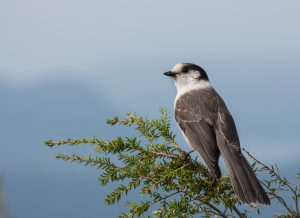
CANADA’S NATIONAL BIRD
We may have a number of national animals but as yet no national bird. Researchers such as Dan Strickland, former Algonquin Park naturalist, biologist….have long promoted the Whiskey Jack. Also known as the Grey Jay (Canadian spelling) Strickland was part of a successful campaign that convinced the American Ornithological Society to officially restore its original name of Canada jay after some six decades. In 2018, the Year of the Bird, a strong initiative to declare the Canada jay as our national bird failed to score points with the federal government. And so, still, no national bird.
Many readers of course can relate camp experiences while canoe tripping in Algonquin Park. The birds are affectionately known as camp robbers on the lookout for handouts; which they often received.
According to a University of Guelph study Canada jay numbers are continuing to decline as the climate continues to morph. The number of Canada jays in southern Ontario is decreasing due to more frequent freeze-thaw days which compromise hidden stored food that varies from berries to roadkill. The food thaws, bacteria grows and food becomes inedible. No food, no energy for reproduction. This study was published in the scientific journal Global Change Biology.
“If your food is being spoiled you have less food that you can devote to survival and reproduction,” said Alex Sutton, a PhD student at the time who co-led the study with associate professor of integrative biology Ryan Norris.
This study employed bird population statistics from 1980 to 2018 as well as environmental data recorded in Algonquin Park since 1977 to look at the effects of the temperature fluctuations on the Canada jay numbers and their food supply. There was a period of poor environmental conditions that negatively impacted Canada jay numbers from which they as yet have not recovered.
Citizen science contributions such as the Christmas bird count help especially when it comes to the effects of climate change on northern populations.
Much of this re-affirms what many readers who have observed the Canada jay over the years already know. Again, it’s always nice to have the science prove what you have long suspected.
Photo – Canadian Geographic